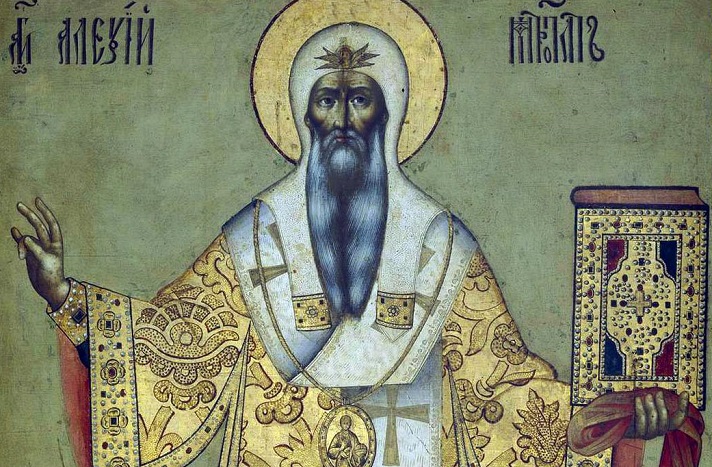
A brilliant statesman who translated the New Testament, built churches and monasteries, developed church canons and promulgated reforms, a diplomat, a man of prayer and a wonderworker – all those words are true of St. Alexius of Moscow. The holy hierarch lived in the age of Tatar yoke. Even heathen Tatars acknowledged the power of his prayers. He was summoned by the Khan to cure the Khan’s wife. Saint Alexius came to the Orda and healed the woman.
Eleftherius (as he was known in the world) was born to the family of a Boyar Theodore Byakont who had escaped the sacked city of Chernigov and gone on to serve Prince Daniel of Moscow. Eleftherius became a monk and adopted the name Alexius in Moscow Holy Epiphany Monastery in 1319. He spent more than twenty years in that monastery.
Alexius traveled to Byzantium in 1354 to be elevated to the rank of a metropolitan. While he was getting ready for the ceremony, he accomplished his secret plan. He made a new translation of the New Testament from Greek into Church Slavonic. The Church preserved the original manuscript, penned by the saint himself, for almost six centuries. The manuscript was known as Chudov New Testament after the place where it was kept, that is, Chudov Monastery, established by St. Alexius. The manuscript was lost after 1917. Fortunately, it had previously been photocopied. Lately, a Greek-Russian dictionary that the saint had compiled while doing his translation, has also been published.
Patriarch Kallistos made Alexius metropolitan of Kiev and All Russia. In spite of the fact that Metropolitan Maximus had moved his residence from Kiev, pillaged by the Mongols, to Vladimir in 1285, the Russian metropolitans were still referred to as metropolitans of “Kiev and All Russia.” It had a profound meaning: in spite of the raids and the destruction of centralized government, the Church remained the primary link that guaranteed spiritual and cultural unity of the nation. The metropolitan’s title symbolized the succession of the ancient Kievan Rus and the new Muscovy.
On their way back, the metropolitan’s ship was caught in a storm. The future Saint Alexius prayed to God asking him to save the ship and promised God to build a monastery in honor of the saint or the feast on whose day the ship would come ashore. They reached the shore on August 16, 1355 – the holiday of the Image of Christ Not-Made-By-Hands. When Alexius returned to Moscow, he established a monastery in honor of the Image of Christ Not-Made-By-Hands. That monastery has survived until our day and is known as Andronikov Monastery of the Savior. Its first abbot was St. Andronik, one of St. Sergius of Radonezh disciples. That monastery is also famous as the place where the great Andrei Rublev spent his last years and found eternal rest.
When the holy metropolitan visited the Orda in 1357 to receive the Khan’s certificate, which was mandatory for all metropolitans in those times and protected the Church from ransacks and violence, the Khan asked St. Alexius to cure his mother Taidula Khatun from blindness. “What you’ve requested is beyond my power but I believe in the One who cured the blind,” the holy hierarch replied, referring to the Gospel story about the miraculous healing of a man who was blind from birth. He recited the necessary prayers, sprinkled the blind woman’s eyes with holy water, and she started to see.
Taidula thanked the metropolitan by giving him a sakkos, embroidered with gold, which is currently stored in the Kremlin Armoury. A sakkos is a vestment, which a bishop wears during church services. Here is the question: How did a Tatar woman, who was allegedly a Muslim, know about traditional vestments worn by the Orthodox clergy (given that the sakkos was well-cut)? How could Saint Alexius, an Orthodox metropolitan, recite prayers and perform rituals over a non-Christian person? The answer is simple: Taidula wasn’t a Tatar. There was a church in v. Urusovo in Ryazan Gubernia back in the 19th century, in which a young priest was said to have served in the early 1300s. He had a pretty wife. When the Mongol hordes plundered their village, they burnt the village down, murdered the priest, and drove his young wife to the capital of their land. They presented the beauty to the Khan. That was how a Russian woman with a tragic fate became a powerful and influential Taidula Khatun. It is said that as soon as Taidula was cured, the Tatar raids stopped while she was alive.
Metropolitan Alexius died in the late 14th century. He was buried in Chudov Monastery in the Kremlin. Grand Prince Sergey Alexandrovich, assassinated by a political terrorist in 1905, was also buried in the basement vault of this monastery. It was here, in front of the relics of St. Alexius, that Grand Princess Elisabeth Feodorovna prayed for her husband’s repose. It was here that the idea to establish Ss. Martha and Mary Convent for prayer and active assistance to the common people came into her head. By the way, the Holy Grand Princess Elisabeth’s monastic name was Alexia).
Prepared by The Catalog of Good Deeds



